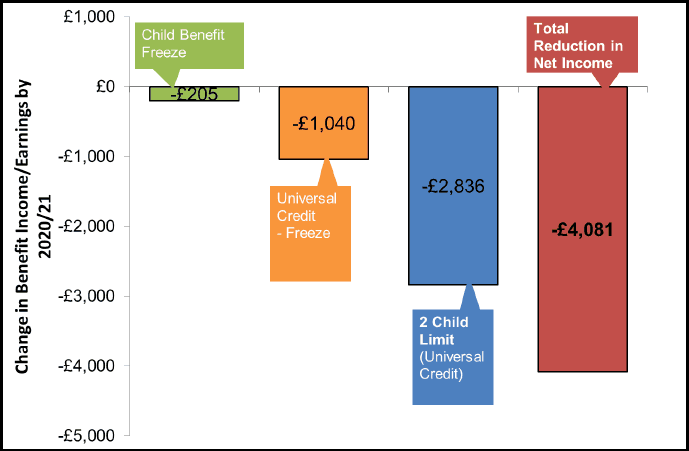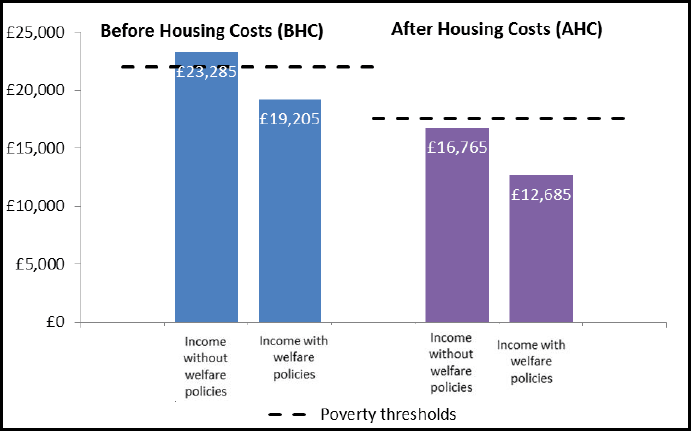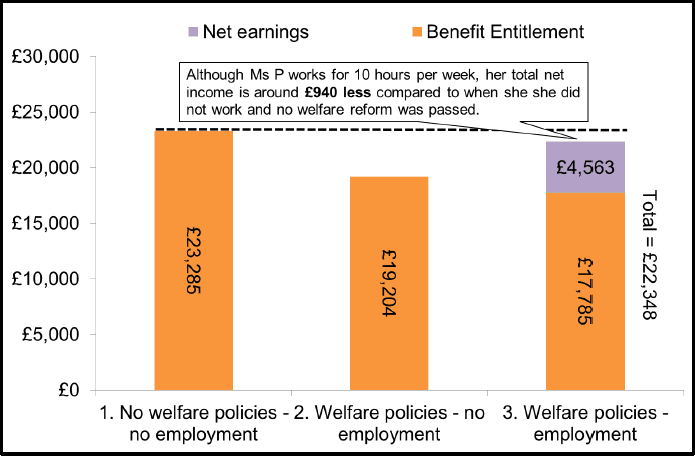UK welfare policy: impact on families with children
Report focusing on the financial impacts of UK welfare policy on families with children.
This document is part of 2 collections
6. Case study 1 – Out of work lone parent with 3 children (Ms P)
Case study 1
Ms P lives with her three children in a 3 bedroom house. Her rent is £125 per week. Ms P claims Universal Credit and Child Benefit and does not work due to childcare duties. As a result of welfare policy changes, she is not entitled to an additional UC child element for her youngest child, as her youngest daughter was born after April 2017. Her youngest daughter turned 2 in 2020.
Total Net Income (2020/21) without welfare policies – £23,285
Total Net Income (2020/21) with all welfare policies - £19,205
- 18% lower
- £4,080 less in Net Income per year
6.1 The impact of welfare policy on Ms P
Around 4,900 out-of-work lone parents claimed Income Support or Universal Credit (as at February 2017) [19] .
As a result of welfare policy changes introduced since 2015/16, Ms P and her family would be worse off by around £78 per week or around £4,080 per year by 2020/21 compared to what her income would have been without the changes in policy. This represents an almost 18% reduction in what Ms P and her family could have been entitled to in 2020/21 had UK these policies not been enacted.
The most significant impact comes from the removal of the UC child element for Ms P's youngest child, which equates to a loss of £2,836 per year, around 70% of the total reduction (see figure 3). The family would also be expected to lose around £1,245 per year due to the four year freeze of Universal Credit elements (£1,040 per year) and Child Benefit (£205 per year) based on latest forecasts of future inflation. Because Ms P is unable to work due to childcare duties, she has no earnings, so her total net income is only affected by welfare policies and not by changes to the National Living Wage. In addition, it is assumed that Ms P has not made a new claim to Universal Credit, but was migrated over from legacy benefits, and is therefore still entitled to the family element (or eldest child element in UC) worth £556 per year.
Figure 3 – Change in annual benefit entitlement due to welfare policy changes by 2020/21 (Case Study 1)

Analysis of future poverty thresholds (see figure 4) suggests that the poverty threshold (before housing costs) for this household in 2020/21 would be around £22,000 per year. This means that, on a before housing cost basis, welfare policies will cause Ms P and her family to have an income below the poverty line by 2020/21.
Figure 4 – Net incomes (with and without welfare policies) against relevant poverty thresholds by 2020/21 (Case Study 1)

Alternatively, on an after housing cost basis, Ms P's net income places her below the poverty line in both scenarios. However, the impact is still significant in terms of distance from the poverty threshold on both measures. Without welfare policy changes Ms P's income is just 5% lower than the relevant poverty threshold, whereas with welfare policy changes Ms P's income is 28% lower.
6.2 The effect of the Benefit Cap on Ms P
Although lone parent families with three children make up 30% of those currently affected by the Benefit Cap [20] , increasingly by 2020-21 three child families (such as Ms P) will not be affected by the Benefit Cap. This is because the removal of the child element for the 3 rd child means Ms P is only entitled to £19,205 per year, which is less than the new Benefit Cap level of £20,000 per year.
If Ms P was not affected by the 2 child limit, she would be affected by the Benefit Cap instead. In this scenario, Ms P would still be around £3,230 per year worse off [21] compared to a scenario with no welfare policies. This shows that whilst the Benefit Cap currently disproportionality affects lone parent households, when the full effects of the 2 child element and removal of the family element are in place, this will no longer be the case. Instead the Benefit Cap is more likely to affect households with high housing costs – this shall be explored more in a future paper on the effect of post 2015 welfare policy changes related to housing.
6.3 The effect of moving into work for Ms P
The analysis above assumed that Ms P would not change her behaviour and so continue to claim Universal Credit and Child Benefit for her three children and not move into employment.
Due to childcare duties, it is unlikely that Ms P could fit work around looking after her three children. For example, DWP current guidance [22] on conditionality states that those with a child under 3 years of age are not expected to be in work immediately. Although it should be noted that families are lone parents are still affected by the Benefit Cap with the implementation of the Benefit Cap to those with children
under 3 being the subject of an on-going High Court case [23] .
However, suppose that Ms P was able to work flexibly for around 10 hours per week. Assuming that she receives the National Living Wage, the increase in earnings is not sufficient to compensate for the impact of reductions in benefit generosity introduced since 2015.
When Ms P moves into part-time work, her net earnings are £4,563 per year if she is paid the National Living Wage (assumed to be £8.75 in 2020/21) and her benefit entitlement (Universal Credit and Child Benefit) falls to £17,785 per year due to the tapering of the UC award. Although she is significantly better off in work , compared to her net income had no welfare policies been passed, she is still £940 per year worse off.
This means that despite Mrs P working 10 hours per week, she is not able to make up the loss from the benefit freeze and the 2 child limit. This is before the additional cost of childcare, travel expenses and other work related expenses are considered for this family.
Figure 5 shows the total net income of Ms P in three scenarios:
1. None of the 2015/16 welfare policies or changes to income tax thresholds or the National Living wage are implemented and MS P does not work any hours. In this case, by 2020/21 Ms P's net income is around £23,290.
2. All 2015/16 welfare policies and other changes are implemented and Ms P does not work. In this case, by 2020/21 her income is around £19,200
3. All 2015/16 welfare policies and other changes are implemented and Ms P does work around 10 hours per week. In this case, by 2020/21 her income is around £22,350.
Figure 5 – The impact on net income of Ms P moving into employment compared to alternative scenarios

Contact
Email: Philip Duffy, Philip.Duffy@gov.scot
Phone: 0300 244 4000 – Central Enquiry Unit
The Scottish Government
St Andrew's House
Regent Road
Edinburgh
EH1 3DG
There is a problem
Thanks for your feedback